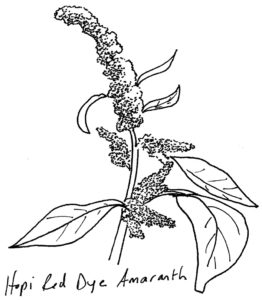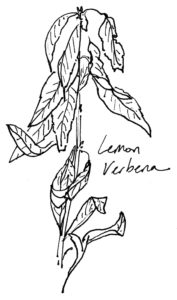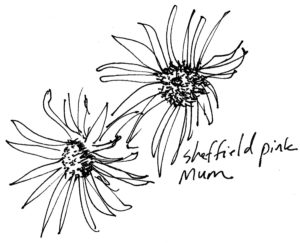Text and Drawings by Abraham Storer
Paula Erickson recently moved from Wellfleet to Truro, where establishing a garden has been a priority for her. It’s an expansive plot and has the feeling of something coming into being. Her dog and cat followed us as she walked me around her “wonderful mess,” where late blossoms, leaves, and seedheads still showed rich colors.
Q: What are you harvesting now? 
I just harvested sweet potatoes, but I’m primarily a flower gardener. The marigolds have just faded. I planted cosmos in late July looking for a fall harvest. I also have Hopi red dye amaranth, which I love for bouquets. The birds love it, too, and it will plant itself and return, so I take off stalks and throw them around. The things that plant themselves do the best.
Q: What else plants itself in your garden?
Sunflowers — though this year many of the seedlings got eaten, some of them just started coming up around the garden. If you stop for a little while you see all the songbirds coming and going, helping themselves. I cut some of the largest sunflower heads to feed to my chickens.

Q: How did these sunflowers get so huge?
They’re heavy feeders. But I got lucky here: when I first dug down, I found two feet of soil. Still, I work a lot of manure, salt marsh hay, and compost into the ground. Salt marsh hay is not only a mulch but adds organic structure to the soil. You don’t want a hermetically sealed garden. You want organic processes happening. I use salt marsh grass to make paths and mulch the garden. It’s free, and it’s always in beautiful places.
Q: What do you appreciate this late in the season?
I’ve become a lemon verbena evangelist. I dry it for tea and gifts all winter. And I got this mum, Sheffield pink, from my friend Stephen Orr. He gave me the plants in June or July, and for a lot of the year it doesn’t do much. You have to be patient with these fall plants. It’s so pretty now, with this peachy tone.
Q: It looks like you plant flowers and vegetables in the same part of the garden.
I like mixing herbs, flowers, and veggies. I believe it helps with pests and brings in beneficial insects. Sometimes placement is about taking shade from the understory. I’ll grow greens or lettuce under tomatoes.
Q: What do your gardening days look like at this time of year?
I’m doing a final weeding. I don’t do a big clearing because I like to leave things for insects, caterpillars, or things getting their start — they need the dying plants and leaf litter. My job in the springtime will be turning that matter into the soil. For garlic, I like to wait closer to the first frost. I will also plant some bulbs soon. I always plant a lot of daffodils, narcissuses, and tulips.
 Q: How do you compost?
Q: How do you compost?
It came to me recently to compost inside the chicken pen. I bring my yard waste, leaves, and organic food scraps, and the chickens turn it for me every day while they’re getting worms and microbes that are good for them. It’s really everything you want, and rodents can’t get in here.
Q: It sounds like symbiosis is a part of your design.
The cycle exists. I’m a lifelong student of how to join it.



